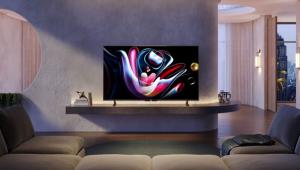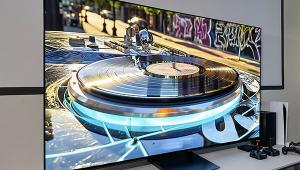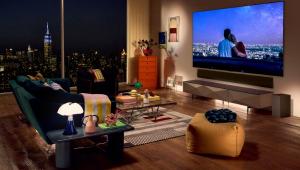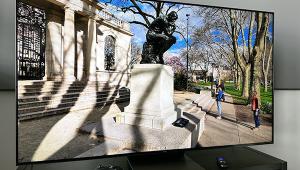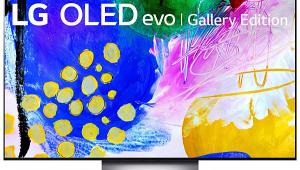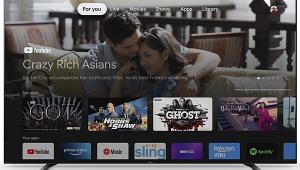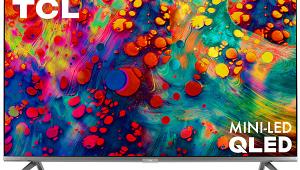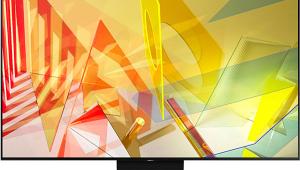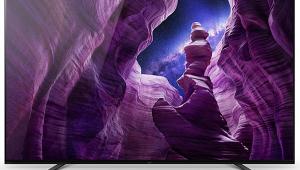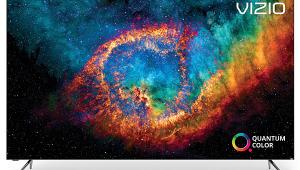OLED money and it's no better than a Samsung LED that costs $2000 less?
Sony XBR-65Z9D LCD Ultra HDTV Review Page 2
 I began with The Martian. In the opening scenes, the (CGI) camera pans across the Mars landscapes, showing a mix of bright areas and dark shadows. It then transitions to a scene of the astronauts conducting experiments. While a few of these scenes still looked a bit too dark, they’ve also looked that way on most of the other HDR sets I’ve reviewed. That said, they’ve never looked better than they did here. My main concern was that the new settings, which greatly increased the visible brightness, would produce images that looked more like a normal SDR source played in Vivid mode. In other words, I feared that everything would simply look too bright. But it didn’t. The spectral balance was now near-ideal: Bright scenes popped, bright highlights in otherwise normal scenes did so as well, and normal scenes of average brightness looked average, and right.
I began with The Martian. In the opening scenes, the (CGI) camera pans across the Mars landscapes, showing a mix of bright areas and dark shadows. It then transitions to a scene of the astronauts conducting experiments. While a few of these scenes still looked a bit too dark, they’ve also looked that way on most of the other HDR sets I’ve reviewed. That said, they’ve never looked better than they did here. My main concern was that the new settings, which greatly increased the visible brightness, would produce images that looked more like a normal SDR source played in Vivid mode. In other words, I feared that everything would simply look too bright. But it didn’t. The spectral balance was now near-ideal: Bright scenes popped, bright highlights in otherwise normal scenes did so as well, and normal scenes of average brightness looked average, and right.
One of my favorite new go-to discs for HDR is Oblivion. At first, I didn’t expect much improvement in the visuals (the standard Blu-ray is excellent), but I was wrong. When the opening title pops up just as Jack approaches his helicopter, you can easily spot the mirror-like reflections in each letter. Later, as Jack gets caught in a thunderstorm, the bolts of lightning jump off the screen. And in the dark, underground library scene—as Jack is chased by the Scavs and as flashes from his rifle light and muzzle land in your lap, punctuating the gloom—you realize you’re not in Kansas anymore.
Comparisons
I set up Sony’s XBR-65Z9D side by side with Samsung’s UN65KS9800FXZA. For 1080p sources, I used an Oppo BDP-105D Blu-ray player (with its Darbee features off). For 4K/HDR, I used the Samsung Ultra HD Blu-ray player. The two sets were linked through an AVProConnect AC-DA12-SUHD HDMI splitter. I adjusted the Samsung TV to match the look of the Sony as closely as possible (equalizing their peak outputs by meter), in both 1080p and UHD/HDR, but I didn’t fully recalibrate the Samsung (it had been calibrated during its review). These altered settings (Backlight, Contrast, Brightness, and Gamma) very likely shifted the Samsung’s older color calibrations off the mark, but I went with them because the visible differences in color between the two sets after tweaking the Samsung were negligible. (With one exception. Read on.) The sets were comparable in their off-center viewing (typically an issue with LCD TVs). They were good for up to 20 degrees, watchable but very slightly faded by 30 degrees, and clearly heading for the door at 45 degrees (though even then, a non-critical viewer might not have noticed).
With a 1080p sharpness pattern, the Sony showed some artificial edge enhancement, subtle but visible even with its Sharpness control at midpoint and Reality Creation turned off. (Midpoint is Sony’s neutral Sharpness setting—though with many brands, including Samsung, it’s zero.) The Sony also slightly softened the resolution lines in the pattern. The Samsung’s pattern was crisp and clean, with no visible edge enhancement even at low settings of its Sharpness control. None of these pattern differences were directly visible from the viewing seat, but the Samsung did look marginally but consistently sharper (without visible enhancement) with 1080p source material. These differences were minor, however, and would never have been obvious without a side-by-side comparison.
It was a surprise to find that with 1080p material, the Samsung ran neck and neck with, or even marginally ahead of, the Sony in black level and shadow detail. On the opening star fields from Avatar (at about 2:16 minutes into the film), the stars were a little dimmer on the Sony and more noticeably so as the brighter ship moved to occupy more of the screen (this will be a function of how a set’s local dimming is configured). The difference wasn’t dramatic, but always favored the Samsung. To improve on this, I tried several different settings on the Sony. None made any significant change in the brightness of the stars, including activating X-tended Dynamic Range at Sony’s recommendation. As noted, this control turns on the Sony’s pseudo-HDR mode. X-tended Dynamic Range did, however, make larger bright areas pop dramatically (particularly a few scenes later in a shot of Pandora, a life-supporting moon, with its host planet behind it). Oddly, the two sets were much closer in the star fields that appear early in Prometheus. And both sets ran neck and neck in that film’s cave scenes.
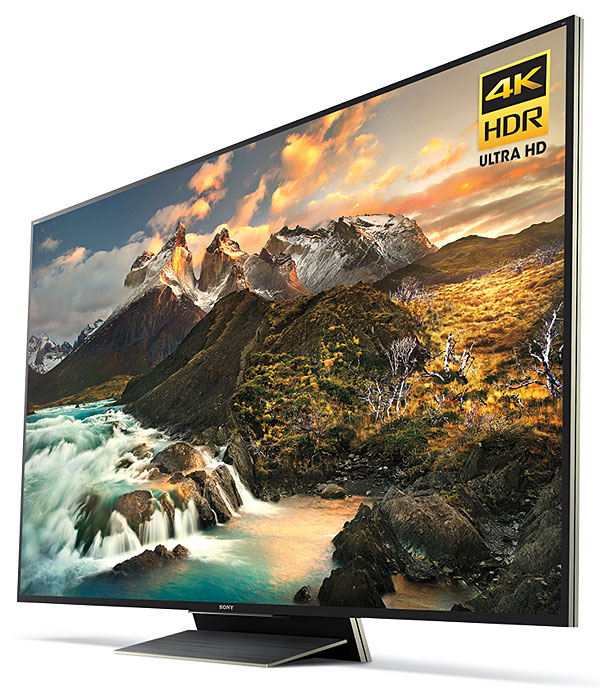
In chapter 9 of Harry Potter and the Deathly Hallows: Part 2, as Neville leads Harry and friends through a dark tunnel and the camera angle shifts to a long shot of the subjects, the Samsung went nearly black in the gloom surrounding them while the same areas on the Sony were a shade or two lighter gray. Ditto for a number of other scenes in this dark movie. It was close, however, and the setting of each set’s black level control (Brightnes on the Samsung, Black level on the Sony) were critical in getting the best from each of them. But as with the sharpness discussion above, short of a direct A/B comparison, most viewers would find the differences between the two sets in both black level and shadow detail insignificant. Both sets are clearly pushing the state of the art in these qualities. The Sony did have the upper hand, however, in its reproduction of red. It was deeper and less orangey than on the Samsung, particularly in a shot of a red Ferrari from an old Pioneer Blu-ray demo disc.
One of the claims made by Sony is that the tightness of the XBR-65Z9D’s LED zones, and their superior collimation (your word of the day!), dramatically reduces the flare or blooming often seen on TVs (particularly, backlit local dimmers) when a bright white or solid color object is set against an otherwise black or very dark background. Visibly, however, the flare on both of these TVs looked about the same, and only marginally better than on most respectable local dimmers.
Moving on to HDR material, I had to make considerable alterations to the Samsung’s controls to achieve a close subjective match to the Sony. After that, it was very much a toss-up. Reds were still somewhat richer on the Sony, which was significant in the landscape scenes from The Martian. The planet’s red desert look was appropriately saturated on the Sony, but it was more like a lightly singed Sahara on the Samsung.
The sets appeared equally crisp in 4K, with no visible resolution differences between them. And while my reference discs for HDR black level and shadow detail are fewer than my discs for 1080p, that underground library scene in Oblivion, with its dark shadows and bright highlights, was equally impressive on both displays.
Searching for other UHD/HDR differences between the two sets would be a fool’s errand. I will say, however, that whereas the Sony still had 10 steps of Brightness (backlighting) and 13 steps of Contrast remaining after I entered my preferred settings, I had to max out the Samsung’s Backlight control and do nearly the same with its Contrast (with only two steps to spare) to get it to be toe-to-toe with the Sony’s visible punch. The Sony is clearly the brighter TV—though in a home setting, I’m not sure how much this will add up to a usable advantage. It might depend on the amount of ambient light in your viewing environment.
Except perhaps for 3D. The Samsung doesn’t do 3D, but the Sony still does. It comes with two pair of active glasses. And its 3D is brilliant, thanks largely to the set’s high available luminance. In scenes from Avatar and Tangled, I found the 3D fully satisfying, with no visible ghosting. When properly set up, the TV boasted a 3D brightness level that was as pleasing as a good SDR 2D presentation. It’s not, of course, anywhere near as dynamic as HDR, but 3D offers its own rewards.
Conclusions
Apart from some minor critiques, the Sony XBR-65Z9D performed superbly on 1080p material. When it comes to HDR, we’re still wandering around a bit in the calibration wilderness, but nevertheless I was seriously impressed by what this TV could do with HDR sources—and you’ll be as well. True, it’s really too early for any of us to know if what we’re seeing from UHD with HDR sources, on any set, is what the filmmakers intended as they graded their movies in those formats. All I can say for certain is this: What I see in HDR is very different from what we’re accustomed to seeing in SDR, but after a brief acclimatization, it looked supremely real on this Sony TV. I want more of it.
- Log in or register to post comments

I would have to concur. Clearly, the fact still remains that unless some other significant technological breakthrough occurs and other than being a little brighter, there are and always be limitations to LCD/LED monitors in performance at a number of levels. In this case when Sony is placing its price level in the range of the current second to the top of the line LG OLED monitor with its superior blacks, off axis performance and both HDR10 and Dolbyvision already onboard, this monitor wouldn't even be a consideration for me and I already have an LG LCD/LED 4K monitor anyway.
I would have to say, once again, Sony missed the price point on this one. $3000-4000 maybe, $5500? no chance.

First, OLED is still in it's infancy and the reliability is a complete unknown. The fact that LG is the only manufacturer pursuing it makes its long term future questionable. Second, I'm not sure how good your settings where but they don't look anything like what I've seen in other reviews and on my own TV which looks nothing like any LCD TV I've ever seen- including the Samsung SUHD you're bragging about. Third, you really do not know what the actual picture was supposed to look like by the film creator, so adjusting settings to make it look good to you does in now way guarantee it is more accurate. Third, nobody does video processing better than Sony- NOBODY- and the panel itself is only half of the story, video processing is the other half, and Sony is light years ahead of Samsung and LG, let alone Vizio and the rest of the Chinese manufacturers. Anyone whose considering this set should read reviews on other sites, Samsung may come close, but still, like I said, video processing trumps all!!

The reason other companies aren't doing OLED is that LG bought the patents for White OLED from Kodak and is the only one that can do it. Samsung and others have to do traditional RGB OLED cells, which is currently too hard to do at scale compared to the WOLD that LG can do. It's not that nobody wants to do it, it's that nobody can do it efficiently and LG isn't licensing out the patent.

That's even more reason to doubt the future of the technology- Historically, Proprietary tech hasn't gone too far or become ubiquitous which is the minimum requirement for a technology to take hold and proliferate, otherwise prices will keep it out of the long term competition. Not many people can afford premium pricing.

Thank you for an honest review of the Z9D! Seems like it was a LONG time coming and I've been wondering why there were so few 'real' reviews. Although I have some issues with my OLED, and I've recently considered exchanging it for a Z9D, I think this review combined with some of the Z9D issues I've seen on the forums, have convinced me to stay with my OLED -- at least for now. Honestly, this TV seems fantastic, and I'm sure I'd love it, especially if the processing makes crappy cable look a little better than it does with OLED! But it seems like I'd be trading one set of shortcomings for another whole, different, set of problems. Think I'll just watch TV, revel in the things my OLED does very well, and forget about trying to have perfection, which ain't gonna happen anytime soon. Thanks again for the review! Very helpful.

The Sony Z9D 65"screen is overpriced, however the 75" screen size is competitively priced.
Everyone has already chimed in on Z9D vs. OLED pricing.
However if you spend some time viewing top end models at 75" Sony Z9D ($9,000), Samsung 78 UN9800 ($9,000) and LG G6P 77'( a whopping $20,000).
You will be surprised and the fact that as an overall display the Z9D beats them in price and in Picture quality (overall, means great for Day time football game viewing in a lighted living room; Gaming; and darken room movie viewing).
OLED's are great for movie viewing in a darkened room, but the brighter the room the lesser their visual impact. In addition, ask all the frustrated gamers who own OLED's, who do indeed play their online games on a darken room, but the lag time for OLED's is poor.
Samsung 9800 is spectacular, in a well lit room. Colors will pop out.
Sony Z9D will beat Samsung in a darken room,come close to matching OLED in a darken room, and finally color accuracy and processing is fantastic.
Both Z9D and the LG OLED do a fair to good job on 3D movies (it still matters to many of us), while Samsung jumped ship on 3D. Which is inexcusable for their top of the line model.
As I stated at the start of my comments, the 65" Sony Z9D is indeed overpriced vs. Samsung 9800 and LG E6 at 65".
However at 75" the Z9D is the better choice among these three displays.
If I were to do all my viewing in an exclusive darken room then an LG 77G6P might be the better choice, but at $20,000 its utterly overpriced.
If I could afford $20,000 then a Sony 4k Projector ($15,000 retail) and a Stewart 100" high gain screen ($5,000) would be the far better option.

I have purchased Sony TVs exclusively since 1978 and had my newest purchase a XBR55X930D delivered Thurs. Well Sony forgot to include the screws to attach the stand. Sony's customer service wanted a copy of my purchase receipt before they would send me the screws. Like who is going to rip off Sony for $3.15 which what they cost on their website. They had issues with my receipt from my on line purchase from Best Buy. Finally they sent the screws but they were too cheap to overnight them. Great job Sony. and Worst Buy sorry best Buy was no help. Maybe I should have spent the extra money for a LG OLED! I never buy another Sony product.

I just got a 75x940D, one step down in Sony's line from the Z9D. Love it so far, blacks are INCREDIBLE. I know, not as good as OLED, but for 1/5th the price of the 77" LG OLED, it's pretty damn good.
I will get a pro calibration after it's broken in for a couple months but wondering how well you think the settings you published for the Z9D would work on the 940D. Right now I know my settings are off. I used the settings from the 65X930D review as a start and tweaked with the Spears and Munsil disc. Great blacks but WAY too bright, and color is noticeably off, too much yellow.
I'm going to put in these settings and see what it looks like.

I bought this 75' Sony late spring 2017 after I found out Sony had dropped 3D from its 2017 line. My choice came down to the Z9D and 2016 LG OLED G6P which also displayed 3D. While the 65" prices were comparable, the 77" LG was $20K. That made the choice simple. The Z9D may not have a black level to match todays OLEDs, but it outperforms any of todays LCD sets, supports Dolby Vision, and still does 3D! There's nothing better than good 3D on a 4K TV. I've also read several reports of the LG G6P's 3D mask failing with no replacements available. If you can still find a Z9D grab it. You won't be disappointed.

The Custom picture mode on the Sony Z9D has a brightness limit and does not support tone mapping. Its main use is for studio monitoring. If you set up your Z9D as described in the S&V review, swap the Custom and Cinema Pro settings (the brightness limit does not affect SDR). Another change I made to the S&V settings was to reduce the Black Level back to the default 50 setting for HDR because on my set it turned normally black bars a dark grey. I can't tell if this results in some black crush, but the grey bars were distracting. Also the screen would not go completely black like it does with SDR material.

Playing Super Mario on a big TV screen is an absolute delight! With its vibrant colors and immersive gameplay, the iconic adventures of Mario and his friends come to life like never before. Experience the nostalgia and excitement of classic gaming in a whole new way. Dive into the world of Super Mario on your big screen and let the fun begin!
Play Super Mario Wonder online now: https://iogamesio.com/super-mario-wonder/

